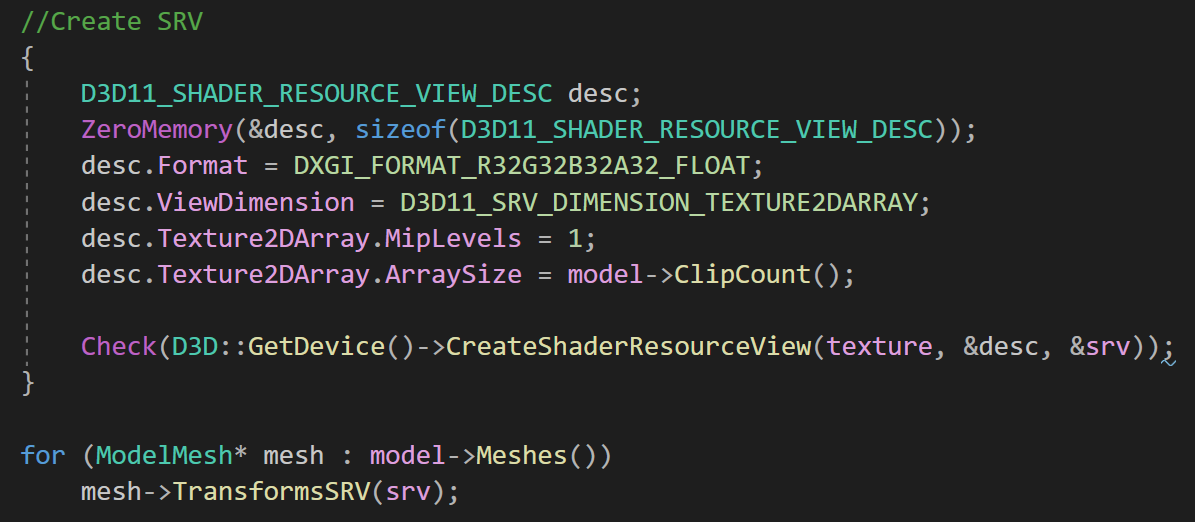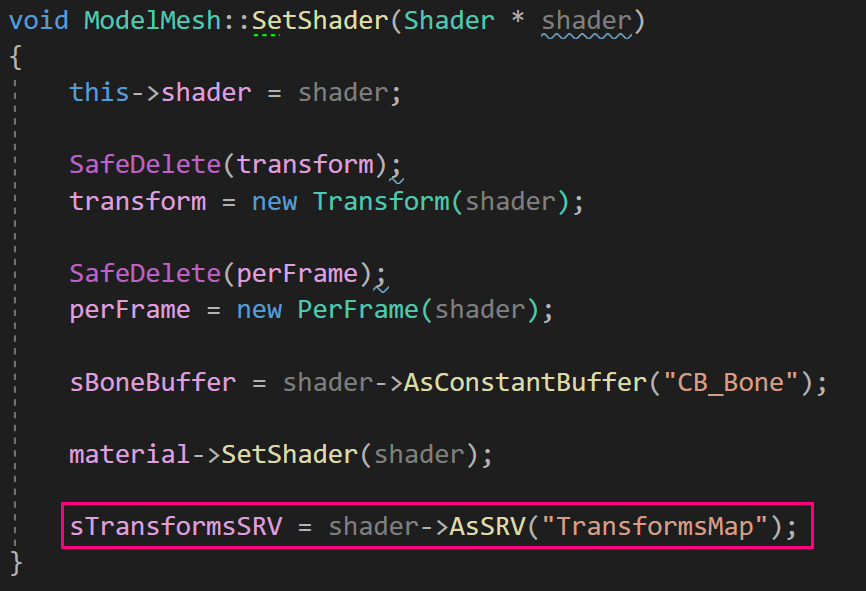🚩 SRV 생성하기


이전에 작성해왔던 Create Texture 함수에 SRV를 생성하는 코드를 추가해주었다.
만들어놨던 Texture2D를 이용해 ResourceView를 생성하고, Model Mesh의 TransformSRV로 지정해주었다.



Model Mesh에는 이러한 애니메이션 TransformSRV를 저장하기 위한 변수를 각각 선언해주었고, Shader에 생성해둔 Texture2DArray인 TransformsMap에 연결해준 뒤 Render해주었다.
📄 45_Animation.fx
#include "00_Global.fx"
float3 Direction = float3(-1, -1, +1);
struct VertexModel
{
float4 Position : Position;
float2 Uv : Uv;
float3 Normal : Normal;
float3 Tangent : Tangent;
float4 BlendIndices : BlendIndices;
float4 BlendWeights : BlendWeights;
};
#define MAX_MODEL_TRANSFORMS 250
#define MAX_MODEL_KEYFRAMES 500
cbuffer CB_Bone
{
matrix BoneTransforms[MAX_MODEL_TRANSFORMS];
uint BoneIndex;
};
struct AnimationFrame
{
int Clip;
uint CurrFrame;
uint NextFrame;
float Time;
float Running;
float3 Padding;
};
cbuffer CB_TweenFrame
{
AnimationFrame Keyframes; // 구조체로 묶어서 전역변수로 사용하기 위함
};
Texture2DArray TransformsMap; // Shader SRV
struct VertexOutput
{
float4 Position : SV_Position;
float3 Normal : Normal;
float2 Uv : Uv;
};
// inout : 파라미터를 입력받아서 출력용으로 보낸다는 의미
void SetAnimationWorld(inout matrix world, VertexModel input)
{
float indices[4] = { input.BlendIndices.x, input.BlendIndices.y, input.BlendIndices.z, input.BlendIndices.w };
float weights[4] = { input.BlendWeights.x, input.BlendWeights.y, input.BlendWeights.z, input.BlendWeights.w };
int clip;
int currFrame;
int nextFrame;
float time;
clip = Keyframes.Clip;
currFrame = Keyframes.CurrFrame;
nextFrame = Keyframes.NextFrame;
time = Keyframes.Time;
float4 c0, c1, c2, c3;
float4 n0, n1, n2, n3;
matrix curr = 0;
matrix transform = 0;
[unroll(4)]
for (int i = 0; i < 4; i++)
{
// X값-열 (indices[i] * 4 + 0) : 4픽셀로 나눠서 들어온 Bone 번호
// Y값-행 (currFrame) : 키 프레임
// Z값-면 (clip) : 애니메이션 클립
c0 = TransformsMap.Load(int4(indices[i] * 4 + 0, currFrame, clip, 0));
c1 = TransformsMap.Load(int4(indices[i] * 4 + 1, currFrame, clip, 0));
c2 = TransformsMap.Load(int4(indices[i] * 4 + 2, currFrame, clip, 0));
c3 = TransformsMap.Load(int4(indices[i] * 4 + 3, currFrame, clip, 0));
curr = matrix(c0, c1, c2, c3);
// weights행렬에 가중치를 누적시켜서 곱하기 => 최종행렬 transform 도출
transform += mul(weights[i], curr);
}
// transform에 World를 구하여 World 상태 행렬 구하기
// transform: 애니메이션이 이동할 행렬 / world: 모델(애니메이션)이 출력될 행렬
// World는 Bone 번호와 키프레임, 클립을 전부 곱한 가중치가 전부 결합되어 만들어진 최종 행렬이 된다.
world = mul(transform, world);
}
VertexOutput VS(VertexModel input)
{
VertexOutput output;
//World = mul(BoneTransforms[BoneIndex], World);
SetAnimationWorld(World, input); // 위에 소스코드 대체
output.Position = WorldPosition(input.Position);
output.Position = ViewProjection(output.Position);
output.Normal = WorldNormal(input.Normal);
output.Uv = input.Uv;
return output;
}
float4 PS(VertexOutput input) : SV_Target
{
float NdotL = dot(normalize(input.Normal), -Direction);
return DiffuseMap.Sample(LinearSampler, input.Uv) * NdotL;
}
technique11 T0
{
P_VP(P0, VS, PS)
P_RS_VP(P1, FillMode_WireFrame, VS, PS)
}Animation을 출력하기 위한 Shader에서는 애니메이션을 출력하기 위해 이동해야하는 transform 행렬과, 모델이 출력될 World 행렬을 각각 연산하여 최종 World 행렬을 구하였다.
이전에 Animation을 출력하기 위해 필요한 정보들(클립, 키프레임, Bone번호)을 조합하여 가중치를 누적합하여 구하였다.

만들어진 쉐이더를 기반으로 Model Animator 클래스에서 데이터를 전달하기 위한 구조체와 버퍼를 각각 선언하였다.

생성자에선 선언한 Buffer를 각각 초기화하고, 쉐이더의 ConstantBuffer로 전달해주었다.

Update에선 ImGui를 이용해 애니메이션의 각 프레임을 출력해보도록 만들었고,
Render에선 프레임 버퍼를 Render하여 애니메이션의 프레임 별 출력이 가능하도록 만들었다.
[ 실행결과 ]

'🎨DirectX' 카테고리의 다른 글
| [DX] Animator 작업 : Animation 실행, TweenFrame (0) | 2023.07.13 |
|---|---|
| [DX] Animator 작업 : Create Texture (Texture2D) (0) | 2023.06.27 |
| [DX] Animator 작업 : Create Clip Transform (bones 연산) (0) | 2023.06.27 |
| [DX] Animation Read Clip (0) | 2023.05.25 |
| [DX] Animation Skin 데이터 : Skinning 기법 (0) | 2023.05.11 |